
The Circaea, or enchanter's nightshades, are a genus of flowering plants in the evening primrose family Onagraceae. About two dozen taxa have been described, including eight species. Plants of the genus occur throughout the temperate and boreal forests of the Northern Hemisphere. Three taxa occur in North America: Circaea alpina, Circaea canadensis, and the hybrid Circaea × sterilis. The generic name Circaea refers to the enchantress Circe from Greek mythology who is said to have used the herb as a charm.

Berytidae is a family of the order Hemiptera, commonly called stilt bugs or thread bugs. Most berytids are brown to yellow, with species that are plant sap feeders, a few being predaceous. About 200 species are known from all around the world and they are classified into three subfamilies.

Nabis limbatus is a species of damsel bug in the family Nabidae. It is found in Northern Europe and the northern part of Western and Central Europe. It occurs in the East in Eastern Europe and across the Palearctic to Siberia to China and Korea. It is introduced in Canada. In the Alps, it rises to about 1400 meters above sea level. In the South of Europe, it is found only in the central uplands.

Coptosoma scutellatum, the soot sprite, is a species of true bugs belonging to the family Plataspidae, subfamily Plataspinae.
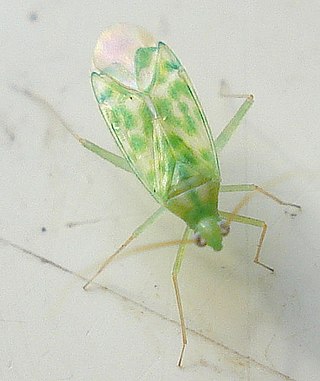
Malacocoris chlorizans is a species of plant bugs belonging to the family Miridae, subfamily Orthotylinae.

Sehirus luctuosus, the Forget-me-not Bug, is a burrowing shieldbug belonging to the family Cydnidae. It is found from Europe to Central Asia.In Central Europe it is widespread and not uncommon. They are found in the Alps on sunny slopes up to almost 2000 meters above sea level.

Neides tipularius is a Palearctic stilt bug. It occurs from the Northern Mediterranean to Scandinavia and the British Isles. Further east it is found in Asia minor and the Caucasus to Central Asia. In Germany and the Alps it is widespread and not uncommon. In Britain it is locally common in large parts of the South. In Ireland it is rare.
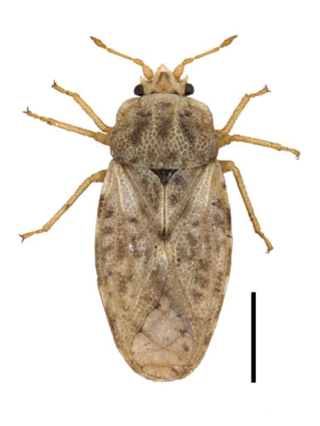
Piesma maculatum is a true bug species found from North Africa to southern parts of Scandinavia and the South of the British Isles then across the Palearctic to the Black Sea region to Central Asia, China and Japan. In Central Europe it is widespread and generally the most common species of the family Piesmatidae.
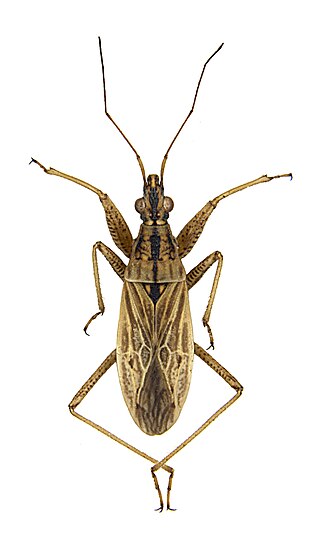
Nabis rugosus, the common damsel bug, is a predatory true bug. The species is found in the Palearctic. It is found in Europe from the North edge of the Mediterranean to southern Scandinavia. Further east, the distribution extends east across the Palearctic to Central Asia and Siberia. The species occurs everywhere in Central Europe and is found in the lowlands, as well as in the central uplands and in the Alps up to about 1500 meters above sea level. It is Central Europe's most common species of sickle bug and it is found in many different habitats, open, dry, shaded and moist; but it prefers moderately moist, half shady places with dominant grass. Adjacent woodland vegetation is equally important.

Aradus depressus is a true bug in the family Aradidae. The species is found in the Palearctic from Ireland East to Siberia. In the Southeast, the range extends to the Caucasus mountains. A. depressus is the most common species of the genus Aradus and can be found everywhere. In the Alps it occurs up to 1,600 metres (5,200 ft).
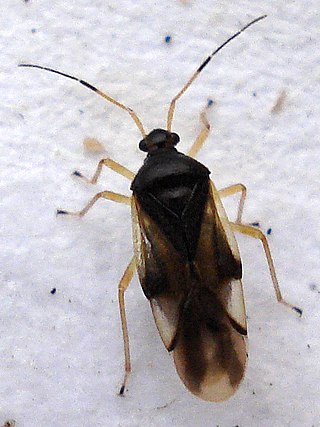
Bryocoris pteridis is a true bug in the family Miridae. The species is found in Europe from Ireland in the West and including the northern edge of the Mediterranean and the East across the Palearctic to Siberia.In Central Europe, it is widespread and occurs both in the central uplands and the Alps up to 1500 metres above sea level.

Monalocoris filicis is a true bug in the family Miridae. The species is found in Europe from Ireland in the West and including the northern edge of the Mediterranean and the East across the Palearctic to Central Asia, Korea and Japan. In Central Europe, it is widespread and generally common. In the Alps, it occurs up to the edge of the forest. Habitats are deciduous and coniferous forests and moist, open habitats such as bogs or the shores of streams.

Drymus brunneus is a species of dirt-colored seed bug in the family Rhyparochromidae found in the Palearctic. In the West Palearctic it is lacking only in the far north of Northern and Eastern Europe. In the East, the species ranges to the Caucasus and Siberia.
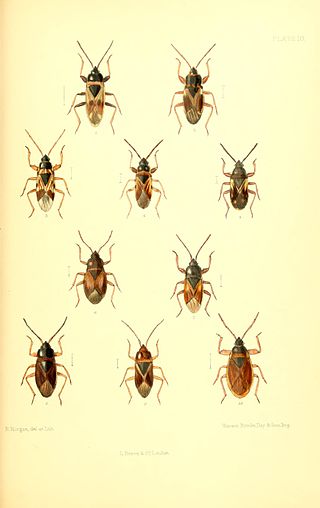
Taphropeltus contractus is a species in the family Lygaeidae. It is found in the West Palearctic - in Europe, excepting the far North. In the South of Europe the distribution includes the Mediterranean Basin including North Africa. The East limit is the Caucasus. In Central Europe the species is widespread and it is not uncommon in the South. North of the central uplands, it occurs but only locally. The species occurs only in warmer in the Alps. It prefers half shady, dry warm habitats.

Orthonotus rufifrons is a species of plant bugs belonging to the family Miridae.

Plagiognathus arbustorum is a species of insects in the family Miridae, the plant bugs.
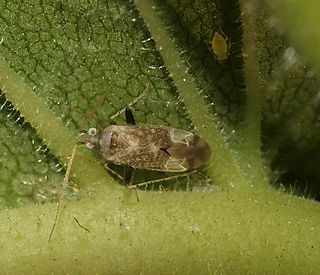
Compsidolon salicellum is a species of plant bug in the family Miridae. It is found in Europe across the Palearctic to Siberia and Korea. It is also found in North America as an Adventive species.

Blepharidopterus angulatus, the black-kneed capsid, is a species of plant bug in the family Miridae. It is found in North Africa, Europe East across the Palearctic to Central Asia and in North America.

Orthocephalus saltator is a Palearctic species of plant bug in the family Miridae. It is found in Europe as far as the Caspian Sea and Siberia and to the south North Africa. O. saltator feeds on Asteraceae especially Hieracium pilosella and Poaceae

Megalonotus praetextatus is a species of seed bug in the family Rhyparochromidae.




















